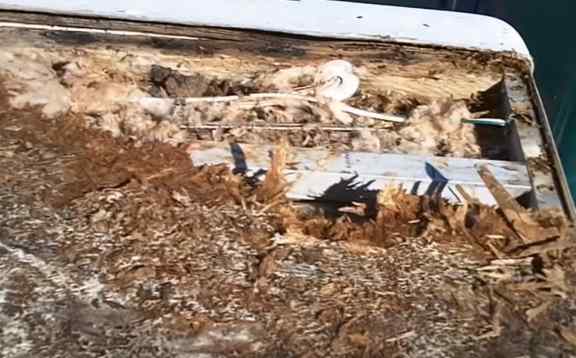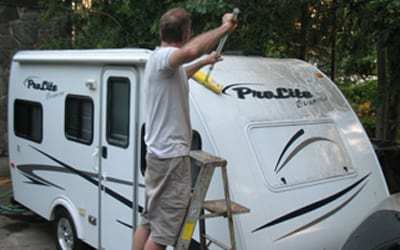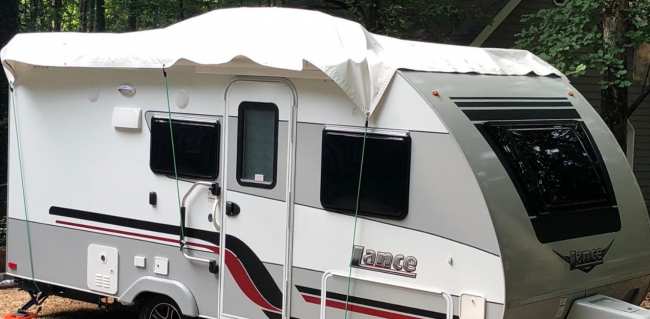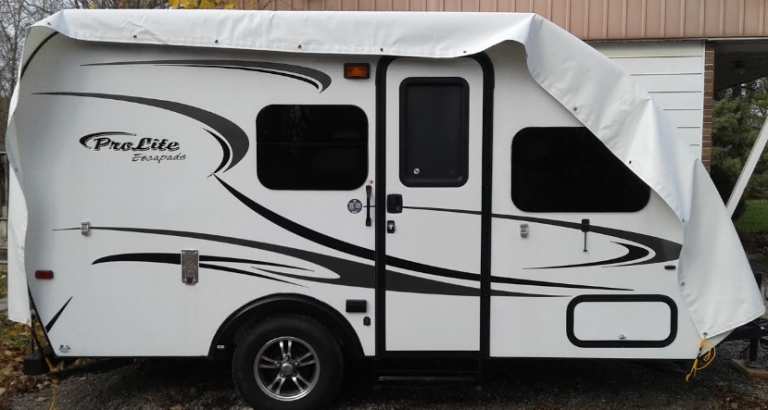
If you own a camper trailer or RV we can't stress enough how important it is to keep these covered year-round with a waterproof vinyl tarp. We have sold dozens of tarps to camper owners whose previous trailers have been ruined by leaks, rot and mold.
Recently, we sold a tarp to a travel trailer owner, in Prince Rupert BC, whose trailer rotted out after just two years and had to be sold for pennies on the dollar.
Don't wait until you see signs of leaks before deciding to cover your trailer with a waterproof tarp. By the time you see evidence of a leak your trailer has likely suffered several thousand dollars in damage. A new quality cover should be your first purchase after buying a new RV.
If you are thinking that your trailer manufacturer includes leek protection in the warranty, be sure to read the fine print. Most of these warranties are only good for one or two years and only warranty against defects in materials and workmanship that result in leaks. The terms may also stipulate that you must have your trailer inspected and/or resealed annually.
Don't take our word for it, just search Google for something like "RV Roof Leak" and read a few articles from angry RV owners. You might be also interested in this podcast discussing the importance of covering your camper.
If you have had a leaking roof in your house you know how much damage this can cause. In most cases, an RV leak is actually a lot worse. Here's why:
It is ironic that trailer owners don't hesitate to take out insurance on their trailers for theft and collision when the chance of these events is extremely remote while, at the same time, some won't spend a couple hundred dollars to protect their trailer from water damage; something that is extremely likely as the trailer ages.
 Even if your trailer doesn't leak, dust and debris are constantly making a mess of the top of your trailer. Climbing a ladder to scrub your RV is hard work and can be dangerous since you can injure yourself and scratch or dent your trailer. Also, you will find that some stains just don't come off or you need to use harsh chemicals to cut through tree sap or mold and mildew. An easier solution is to cover your trailer with one of our heavy duty tarps and when that gets dirty you simply take it down and place it on your driveway or lawn and scrub it down. This keeps your travel trailer looking like new for many years and eliminates the need to use solvents on your trailer, which can damage the surface.
Even if your trailer doesn't leak, dust and debris are constantly making a mess of the top of your trailer. Climbing a ladder to scrub your RV is hard work and can be dangerous since you can injure yourself and scratch or dent your trailer. Also, you will find that some stains just don't come off or you need to use harsh chemicals to cut through tree sap or mold and mildew. An easier solution is to cover your trailer with one of our heavy duty tarps and when that gets dirty you simply take it down and place it on your driveway or lawn and scrub it down. This keeps your travel trailer looking like new for many years and eliminates the need to use solvents on your trailer, which can damage the surface.
Ants are another common hazard for RVs and trailers that are parked beneath trees. Trees drip tiny sap droplets that not only stain the top of your trailer but also attract ants and other insects. As the ants harvest the sap they often penetrate the sealants on top of the trailer causing leakage and eventually holes large enough for the ant colonies to tunnel through. You have invested thousands of dollars in your travel trailer or motor home. Now is the time to spend a few dollars to ensure it will last for many years.
Our durable tarpaulins are available in a range of colors but we recommend a light color such as white or grey to keep your travel trailer cooler in the summer. Because of the substantial weight of our tarps, you will find that you barely need to tie them down to keep them from blowing off. Our custom, made-to-order, vinyl tarps are designed to last for up to 10 years without leaking.
The top of the trailer is the most important area to be fully covered. We recommend that you also cover a few inches down the sides and most of the ends. This will allow the trailer to breathe while protecting it from water damage. If the front of the camper is slanted, the tarp should cover to the point where the side of the trailer becomes vertical so that the water that runs off the tarp falls to the ground, not onto the trailer. If your trailer has an air conditioner on top, be sure to add enough material in both directions to go over the air conditioner (and skylights, etc.) and still reach the sides.
 Here is an example of a tarp that was ordered too short. The length of the sides and the back look about right. The problem is that the tarp does not come down far enough at the front. When water drains off the tarp it will run directly onto the front of the trailer causing staining and the potential for leaks. This tarp should really have been ordered about seven feet longer to be 100% effective.
Here is an example of a tarp that was ordered too short. The length of the sides and the back look about right. The problem is that the tarp does not come down far enough at the front. When water drains off the tarp it will run directly onto the front of the trailer causing staining and the potential for leaks. This tarp should really have been ordered about seven feet longer to be 100% effective.When deciding on the correct width, keep in mind that you generally want the edge of the tarp to hang above the door so that it does not get in your way when you go in and out.
You usually don't need very many grommets to keep your RV tarp secure. Think about where you plan to attach the grommets and use this to determine where the grommets should be placed. There is no point in adding grommets that don't get used. You can even send us a diagram to let us know the exact grommet positions you would like us to use if you don't want them evenly spaced.
 Here we show an example of a tarp that was sized perfectly so that rainwater sheds to the ground, not onto the trailer. If you find that the sides of the tarp droop down and get too close to the trailer, you might want to consider sliding a few 2x4 boards straddled across the top of your trailer. If these are sized say about one foot wider than the trailer this would force the sides of the tarp to extend about 6" in either side of the trailer to promote better runoff.
Here we show an example of a tarp that was sized perfectly so that rainwater sheds to the ground, not onto the trailer. If you find that the sides of the tarp droop down and get too close to the trailer, you might want to consider sliding a few 2x4 boards straddled across the top of your trailer. If these are sized say about one foot wider than the trailer this would force the sides of the tarp to extend about 6" in either side of the trailer to promote better runoff.
The one thing to notice about this tarp is that there are likely more grommets than are needed. Since the side of the trailer does not have many fastening points to tie into, many of the grommets will likely go unused. Unless your trailer is parked in a very windy area, usually you only need 6 - 8 grommets to secure it. It is not a big deal to have extra grommets, especially if you plan to multi-purpose this tarp. For example, if you are planning to hang it above the trailer when you are camping to provide shade and rain protection you might be glad to have the extra grommets to fasten to tree branches.
